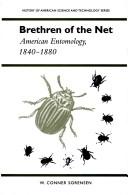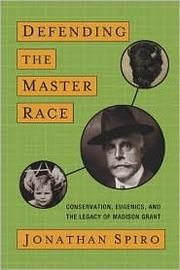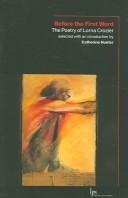| Listing 1 - 10 of 35 | << page >> |
Sort by
|
Book
ISBN: 1350191132 1350191124 Year: 2021 Publisher: London, England : Bloomsbury Visual Arts,
Abstract | Keywords | Export | Availability | Bookmark
 Loading...
Loading...Choose an application
- Reference Manager
- EndNote
- RefWorks (Direct export to RefWorks)
"Scottish zoologist D'Arcy Wentworth Thompson's visionary ideas in On Growth and Form continue to evolve a century after its publication, aligning it with current developments in art and science. Practitioners, theorists, and historians from art, science, and design reflect on his ongoing influence. Overall, the anthology links evolutionary theory to form generation in both scientific and cultural domains. It offers a close look at the ways cells, organisms, and rules become generative in fields often otherwise disconnected. United by Thompson's original exploration of how physical forces propel and shape living and nonliving forms, essays range from art, art history, and neuroscience to architecture, design, and biology. Contributors explore how translations are made from the discipline of biology to the cultural arena. They reflect on how Thompson's study relates to the current sciences of epigenesis, self-organization, biological complex systems, and the expanded evolutionary synthesis. Cross-disciplinary contributors explore the wide-ranging aesthetic ramifications of these sciences. A timeline links the history of evolutionary theory with cultural achievements, providing the reader with a valuable resource"--
Book
ISBN: 1610911458 1597269182 Year: 2004 Publisher: Washington, D.C. : Island Press/Shearwater Books,
Abstract | Keywords | Export | Availability | Bookmark
 Loading...
Loading...Choose an application
- Reference Manager
- EndNote
- RefWorks (Direct export to RefWorks)
Zoologists --- Explorers --- Beebe, William,
Book
ISBN: 110704930X 1108067778 Year: 1840 Publisher: Place of publication not identified : Cambridge : publisher not identified, Cambridge University Press
Abstract | Keywords | Export | Availability | Bookmark
 Loading...
Loading...Choose an application
- Reference Manager
- EndNote
- RefWorks (Direct export to RefWorks)
First published in 1840 as a volume in the Cabinet Cyclopaedia - a series published between 1830 and 1844, intended for the self-educating middle class - this work was written by the naturalist and artist William Swainson (1789-1855). The first part is a treatise on taxidermy, showcasing methods of Victorian science that may appear gruesome to modern readers. It discusses the best ways to collect, preserve and present animals for scientific study. Swainson gives detailed advice, making allowances for naturalists working in different locations and searching for a range of species. The directions for skinning and mounting animals are not for the faint-hearted, but they offer a fascinating insight into the practices of the time. The work's second part is a zoological bibliography, with short biographies of notable authors. Zoological painters and engravers, such as Thomas Bewick (1753-1828), are also featured.
Taxidermy. --- Zoologists --- Animal scientists --- Biologists --- Zoological specimens --- Collection and preservation
Book
ISBN: 1607812150 9781607812159 9781607811787 1607811782 9781607811534 1607811537 Year: 2012 Publisher: Salt Lake City : University of Utah Press,
Abstract | Keywords | Export | Availability | Bookmark
 Loading...
Loading...Choose an application
- Reference Manager
- EndNote
- RefWorks (Direct export to RefWorks)
Wildlife conservationists --- Primatologists --- Primates --- Conservationists --- Zoologists --- Quadrumana --- Mammals --- Research --- Conservation
Book
ISBN: 0773599746 9780773599741 9780773599758 0773599754 9780773547995 0773547991 0773547991 9780773547995 0228009170 Year: 2016 Publisher: Montreal, [Ontario] : McGill-Queen's University Press,
Abstract | Keywords | Export | Availability | Bookmark
 Loading...
Loading...Choose an application
- Reference Manager
- EndNote
- RefWorks (Direct export to RefWorks)
When Anne Innis saw her first giraffe at the age of three, she was smitten. She knew she had to learn more about this marvellous animal. Twenty years later, now a trained zoologist, she set off alone to Africa to study the behaviour of giraffe in the wild. Subsequently, Jane Goodall and Dian Fossey would be driven by a similar devotion to study the behaviour of wild apes.In Smitten by Giraffe the noted feminist reflects on her scientific work as well as the leading role she has played in numerous activist campaigns. On returning home to Canada, Anne married physicist Ian Dagg, had three children, published a number of scientific papers, taught at several local universities, and in 1967 earned her PhD in biology at the University of Waterloo. Dagg was continually frustrated in her efforts to secure a position as a tenured professor despite her many publications and exemplary teaching record. Finally she opted instead to pursue her research as an independent “citizen scientist,” while working part-time as an academic advisor. Dagg would spend many years fighting against the marginalization of women in the arts and sciences.Boldly documenting widespread sexism in universities while also discussing Dagg’s involvement with important zoological topics such as homosexuality, infanticide, sociobiology, and taxonomy, Smitten by Giraffe offers an inside perspective on the workings of scientific research and debate, the history of academia, and the rise of second-wave feminism. A new preface relates Dagg’s experience as the subject of the documentary The Woman Who Loves Giraffes.
Women scientists --- Women zoologists --- Women animal specialists --- Women biologists --- Zoologists --- Scientists --- Women in science --- STEM. --- academia. --- autobiography. --- environment. --- feminism. --- giraffes. --- research. --- science. --- sexism. --- sociobiology. --- taxonomy. --- universities. --- women.
Book
ISBN: 0674039025 9780674039025 9780674029743 0674029747 9780674048423 0674048423 0674264681 Year: 2008 Publisher: Cambridge, Mass. : Harvard University Press,
Abstract | Keywords | Export | Availability | Bookmark
 Loading...
Loading...Choose an application
- Reference Manager
- EndNote
- RefWorks (Direct export to RefWorks)
In 2005 Jackson ventured into the remote swamp forests of the northern Congo to collect reptiles and amphibians. This book is Jackson's unvarnished account of her research on the front lines of the global biodiversity crisis-coping with interminable delays in obtaining permits, learning to outrun advancing army ants, subsisting on a diet of Spam and manioc, and ultimately falling in love with the strangely beautiful flooded forest.
Herpetologists --- Poisonous snakes --- Venomous snakes --- Vipers --- Poisonous animals --- Snakes --- Zoologists --- Jackson, Kate,

ISBN: 0585325596 9780585325590 0817307559 Year: 1995 Publisher: Tuscaloosa : University of Alabama Press,
Abstract | Keywords | Export | Availability | Bookmark
 Loading...
Loading...Choose an application
- Reference Manager
- EndNote
- RefWorks (Direct export to RefWorks)
Sorensen asks how it came about that, within the span of forty years, the American entomological community developed from a few gentlemen naturalists with primary links to Europe to a thriving scientific community exercising world leadership in entomological science. He investigates the relationship between American and European entomology, the background of American entomologists, the implications of entomological theory, and the specific links between 19th-century American society and the rapid institutional growth and advances in theoretical and applied entomology. This book illuminates an important period in entomological research and describes the careers and scientific concerns of hundreds of little-known American men and women. With implications for the history of entomology, the history of science, and American social and intellectual history, this study invites comparisons with other professional scientific groups, such as the geologists and botanists. Sorensen suggests that Americans contributed more directly to evolutionary theory than has been recognized. He also suggests that a decentralized, federal political structure in the United States provided a more congenial environment for natural history investigations than did the centralized structures of European states. Based primarily on the correspondence of American entomologists, Brethren of the Net draws together information from diverse sources to illuminate an important chapter in the history of American science.
Entomology --- Entomologists --- Zoology --- Health & Biological Sciences --- Invertebrates & Protozoa --- Insect scientists --- Zoologists --- Insects --- History. --- History
Book
ISBN: 081739222X 9780817392222 9780817320096 0817320091 Year: 2019 Publisher: The University of Alabama Press
Abstract | Keywords | Export | Availability | Bookmark
 Loading...
Loading...Choose an application
- Reference Manager
- EndNote
- RefWorks (Direct export to RefWorks)
Entomologists --- Insect scientists --- Zoologists --- Riley, Charles V. --- Riley, Charles Valentine, --- Riley, Chas. V. --- Riley, C. V.

ISBN: 1282472828 9786612472824 158465810X 9781584658108 9781584657156 1584657154 Year: 2009 Publisher: Burlington, Vermont : University of Vermont Press,
Abstract | Keywords | Export | Availability | Bookmark
 Loading...
Loading...Choose an application
- Reference Manager
- EndNote
- RefWorks (Direct export to RefWorks)
A historical rediscovery of one of the heroic founders of the conservation movement who was also one of the most infamous racists in American history
Racism --- Eugenics --- Zoologists --- Wildlife management --- Big game hunting --- Hunters --- Conservationists --- History. --- Grant, Madison, --- Influence. --- United States --- Race relations.

ISBN: 1554586623 128037750X 9786610377503 0889205396 142376109X 6610377502 9781423761099 9780889204898 0889204896 9780889204638 0889204632 9780889205390 9781280377501 0889204632 9781554586622 Year: 2006 Publisher: Waterloo, Ont. : Wilfrid Laurier University Press,
Abstract | Keywords | Export | Availability | Bookmark
 Loading...
Loading...Choose an application
- Reference Manager
- EndNote
- RefWorks (Direct export to RefWorks)
In the 1950s, Anne Innis Dagg was a young zoologist with a lifelong love of giraffe and a dream to study them in Africa. Based on extensive journals and letters home, Pursuing Giraffe vividly chronicles the realization of that dream and the year that she spent studying and documenting giraffe behaviour. Dagg was one of the first zoologists to study wild animals in Africa (before Jane Goodall and Dian Fossey); her memoir captures her youthful enthusiasm for her journey, as well as her näiveté about the complex social and political issues in Africa. Once in the field, she recorded the complexities of giraffe social relationships but also learned about human relationships in the context of apartheid in South Africa and colonialism in Tanganyika (Tanzania) and Kenya. Hospitality and friendship were readily extended to her as a white woman, but she was shocked by the racism of the colonial whites in Africa. Reflecting the twenty-three-year-old author’s response to an “exotic” world far removed from the Toronto where she grew up, the book records her visits to Zanzibar and Victoria Falls and her climb of Mount Kilimanjaro. Pursuing Giraffe is a fascinating account that has much to say about the status of women in the mid-twentieth century. The book’s foreword by South African novelist Mark Behr (author of The Smell of Apples and Embrace) provides further context for and insights into Dagg’s narrative.
Zoologists --- Giraffe --- Animal scientists --- Biologists --- Giraffa camelopardalis --- Giraffes --- Giraffa --- Behavior --- Dagg, Anne Innis --- Travel --- Africa --- Description and travel. --- Description and travel --- Dagg, Anne Innis, --- Dagg, A. I.,
| Listing 1 - 10 of 35 | << page >> |
Sort by
|

 Search
Search Feedback
Feedback About UniCat
About UniCat  Help
Help News
News